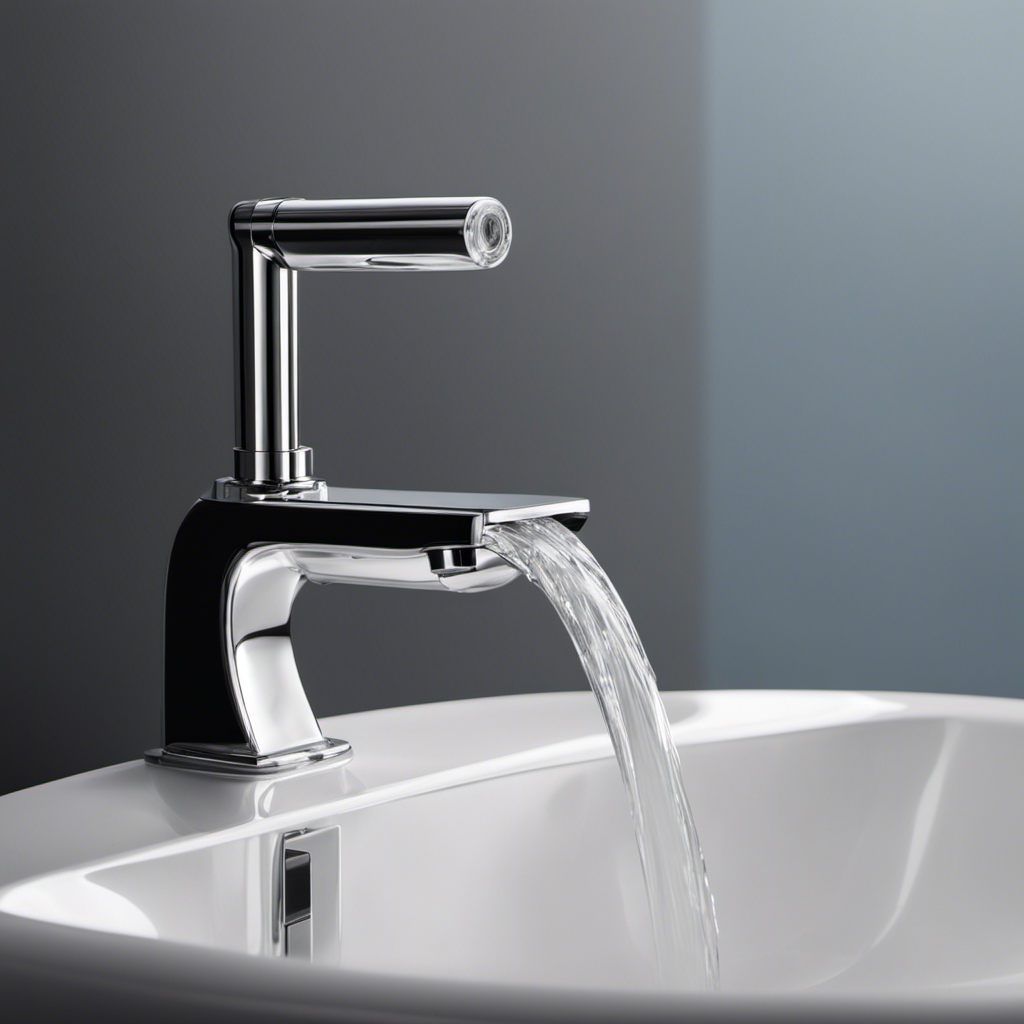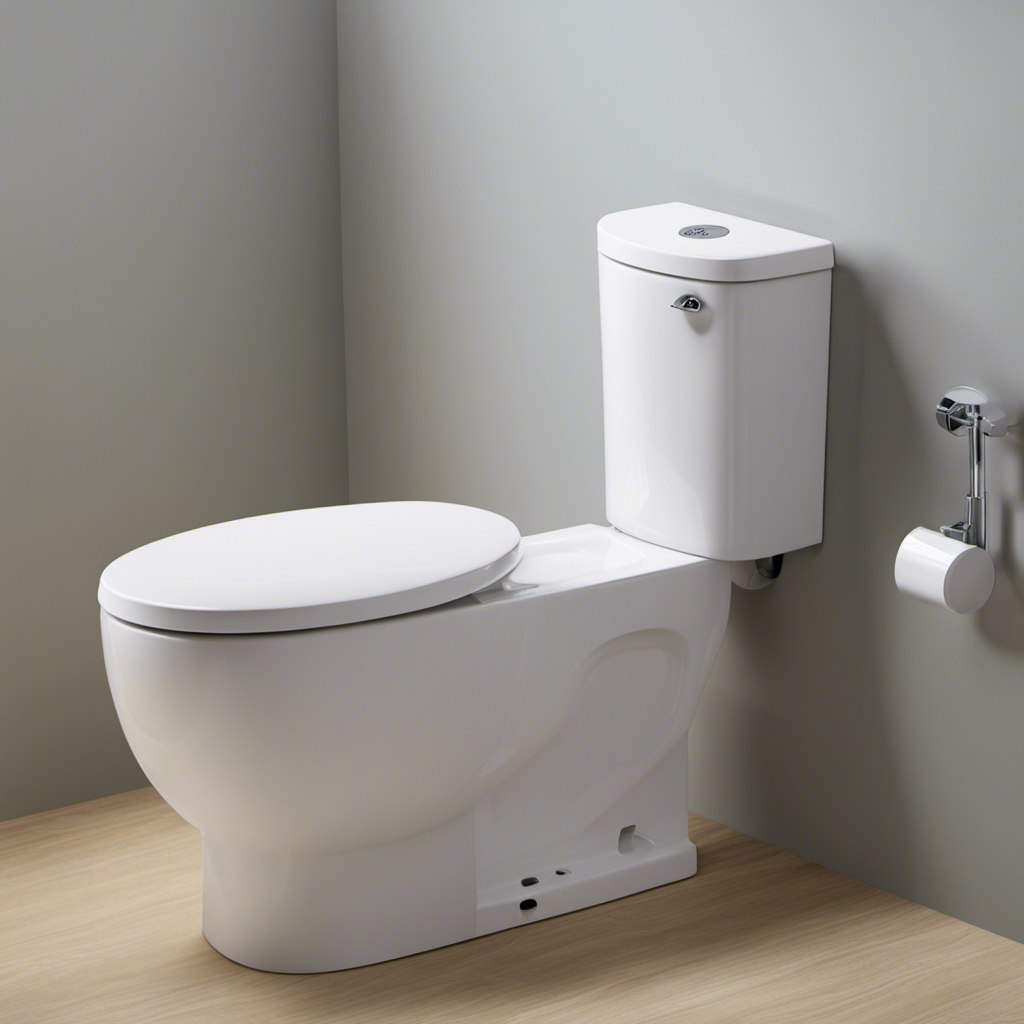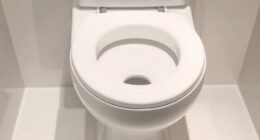Did you know that the average American household uses about 140,000 gallons of water every year?
One area where we can reduce our water consumption is by adjusting the water level in our toilets.
In this article, I will guide you through the process of assessing the current water level, understanding the water fill valve, and making adjustments to ensure an efficient and effective flush.
By maintaining the proper water level, you can save water and contribute to a more sustainable future.
Key Takeaways
- Adjusting water level in toilets helps reduce water consumption.
- Understanding the water fill valve is crucial in adjusting water level.
- Troubleshooting common issues with the water fill valve can improve flushing performance and prevent leaks.
- Adjusting the water height by turning the screw on the fill valve allows for achieving the desired water level in the toilet tank.
Assessing the Current Water Level
You’ll want to start by checking if the current water level in your toilet is too high or too low. To do this, remove the tank lid and observe the water level. If it is too high, it may cause the toilet to constantly run or even overflow.
In this case, you’ll need to lower the water level by adjusting the water flow. On the other hand, if the water level is too low, it may result in poor flushing performance. To address this, you’ll need to evaluate the water pressure and adjust the water flow accordingly.
Understanding the water fill valve is crucial in this process, as it regulates the water level in the tank. Now let’s dive deeper into how the water fill valve works and how to adjust it.
Understanding the Water Fill Valve
In this discussion, I’ll be delving into the topic of understanding the water fill valve and its importance in maintaining an optimal water level in the toilet tank.
We will explore the key points of achieving the ideal water level, as well as troubleshooting common issues that may arise with the water fill valve.
Optimal Water Level
The optimal water level in the toilet tank should be adjusted to ensure proper flushing. Maintaining water efficiency and preventing water waste are crucial for conserving our precious resources. Here are three reasons why adjusting the water level in your toilet tank is important:
-
Improved flushing performance: By setting the water level to the optimal height, you allow for a stronger flush, ensuring that waste is effectively removed with minimal water usage.
-
Reduced water waste: A higher water level than necessary means more water is used for each flush, leading to unnecessary water waste. Adjusting the water level helps conserve water and reduce your utility bills.
-
Preventing potential leaks: If the water level is too high, it can result in constant leakage, leading to water wastage and higher bills. Adjusting the water level helps prevent leaks and avoids unnecessary water loss.
Troubleshooting Common Issues
If you notice any unusual sounds or slow flushing, it could be a sign of a common issue with your toilet. One of the most common problems that can cause slow flushing is a low water level in the toilet tank.
To fix this issue, you need to perform some basic toilet tank maintenance. First, check the water level in the tank and make sure it is at the recommended level, usually marked on the inside of the tank. If the water level is low, adjust the fill valve to increase the water level. You can do this by turning the adjustment screw on top of the fill valve clockwise. Keep adjusting until the water level reaches the recommended mark.
This simple fix can help improve the flushing performance of your toilet and prevent any further issues.
Adjusting the Water Height
To adjust the water level in the toilet, you can simply turn the screw on the fill valve. This will allow you to control the amount of water that fills up the tank after each flush.
Here are some key steps to follow:
- Locate the fill valve, which is usually located on the left side of the toilet tank.
- Use a flathead screwdriver to turn the screw clockwise to decrease the water level or counterclockwise to increase it.
- Flush the toilet and observe the water level in the tank. Adjust the screw as needed until you achieve the desired water level.
It’s important to note that adjusting the water level can also help with adjusting water pressure and preventing leaks. Additionally, some toilets have water level indicators that can help you determine the ideal water level.
Troubleshooting Common Issues
When it comes to troubleshooting common issues with toilets, two key problems that often arise are low water level and an overflowing toilet.
Low water level can be caused by a variety of factors, such as a faulty fill valve or a clogged water supply line.
On the other hand, an overflowing toilet is typically caused by a blockage in the drain pipe or a malfunctioning flush valve.
In this discussion, I will explore the causes and potential solutions for both these issues, providing technical and informative guidance to help address these problems effectively.
Low Water Level
The toilet’s water level is too low, which can be adjusted to ensure proper flushing. To increase the water level and prevent water waste, follow these steps:
-
Check the fill valve: Make sure the fill valve is fully open to allow more water into the tank.
-
Adjust the float: Locate the float inside the tank and adjust it to a higher position. This will allow the water to rise to a higher level.
-
Replace the flapper: If the flapper is old or worn out, it may not be sealing properly, causing water to leak out. Replace it to prevent water waste.
By increasing the water level in your toilet, you can ensure that it flushes properly and prevents water waste.
Regular maintenance and adjustments will help maintain an efficient and functional toilet system.
Overflowing Toilet
Make sure you quickly address the issue of an overflowing toilet to prevent further water damage.
When a toilet overflows, it is usually due to a toilet clog or a malfunctioning toilet mechanism.
To stop the overflow, locate the water shut-off valve near the base of the toilet and turn it clockwise to stop the flow of water.
Next, remove the tank lid and check if the flapper is stuck in the open position. If so, gently push it down to close it.
If the flapper is fine, the clog may be deeper in the drain pipe. In this case, you may need to use a plunger or a toilet auger to clear the clog.
If the problem persists, it is best to contact a professional for toilet repair.
Checking for Leaks
To check for leaks, you should start by turning off the water supply to the toilet. Leaks can cause water damage and increase your water bill, so it’s important to find and fix them promptly.
Here are some steps to help you in finding the source and fixing leaks:
-
Inspect the toilet tank and bowl for any visible signs of water leakage, such as puddles or wet spots.
-
Check the water supply line and connections, ensuring they are tight and secure.
-
Test the flapper valve by adding a few drops of food coloring to the tank. If the color appears in the bowl after a few minutes, you have a leaky flapper valve that needs to be replaced.
Fixing leaks may involve replacing faulty parts or tightening connections. If you’re unsure or the leak persists, it’s best to consult a professional plumber for further assistance.
Maintaining the Proper Water Level
Maintaining the proper water level in your toilet is crucial for its efficient operation and preventing potential issues. To ensure that the water level is correct, there are a few steps you can take.
First, evaluate the water pressure coming into your toilet. If the pressure is too high, it can cause the water level to rise excessively. Adjusting the water pressure regulator can help solve this problem.
Next, check for blockages in the toilet’s fill valve or the refill tube. These blockages can prevent water from filling the tank properly, leading to an incorrect water level. Clearing any obstructions should resolve the issue.
Frequently Asked Questions
How Do I Know if My Toilet’s Water Level Is Too High or Too Low?
To determine if my toilet’s water level is too high or too low, I can visually inspect the water level in the bowl. If it is too high, it may indicate a problem with the fill valve or float. If it is too low, it could be due to a clogged or improperly adjusted flapper valve. Toilet water level maintenance is crucial for proper functioning. Troubleshooting toilet water level issues involves checking these components.
Can I Adjust the Water Level in My Toilet Without Using the Water Fill Valve?
I can adjust the water level in my toilet without using the water fill valve. There are alternative methods that can be used to adjust the water level to ensure proper functioning.
Why Does the Water Level in My Toilet Keep Fluctuating?
The water level in my toilet keeps fluctuating due to various causes. Troubleshooting toilet water level issues involves checking for leaks, adjusting the fill valve, or inspecting the flapper valve for any damage or debris.
What Should I Do if Adjusting the Water Level Does Not Fix the Problem?
If adjusting the water level doesn’t solve the problem, there are alternative solutions you can try. However, if those don’t work either, it may be time to seek professional help.
How Often Should I Check for Leaks in My Toilet’s Water Level?
I check for leaks in my toilet’s water level regularly to ensure proper maintenance. This is crucial for preventing toilet water leaks and ensuring the correct functioning of the toilet.
Conclusion
To conclude, adjusting the toilet water level is a simple process that can be done by anyone. By assessing the current water level and understanding the water fill valve, you can easily adjust the water height to your preference.
Troubleshooting common issues and checking for leaks are also important to ensure the proper functioning of your toilet. Maintaining the proper water level is essential for water conservation and reducing water wastage. Did you know that a leaking toilet can waste up to 200 gallons of water per day?
So, it’s crucial to regularly check and adjust the water level to save water and money.










